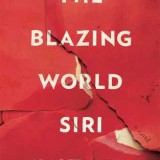
Review: The Blazing World by Siri Hustvedt
Positives
Negatives
“Reviewers of every ilk like to feel they are above a work of art. If it puzzles them or if they are intimidated, they are more likely to trash it. Many artists are not intellectuals, but Burden was, and her work reflected wide learning.”
It’s tough to crack a mystery when you know you have one on your hands. It’s even tougher when you aren’t sure if what you are experiencing is, in fact, a puzzle or if you are just missing something entirely. The Blazing World by Siri Hustvedt is a peculiar epistolary novel. The facts present themselves from the beginning. Harriet Burden (Harry), who has largely been ignored by the art world, creates a plan to achieve success. She unveils her work, but her name is absent from it. People, mostly critics, doubt her when she claims ownership. Through a series of letters and varied viewpoints, an audience finds the “real” Harry.
Harriet Burden is a character who is reminiscent of that grumpy, morbid, and insanely intelligent classmate in graduate school that everyone respected but feared. She’s the best part of The Blazing World because she’s so flawed yet relatable. You walk away remembering her. Hustvedt’s introduction of Harry demands attention: “I, Harriet Burden, also known as Harry to my old friends and select new friends, am sixty-two, not ancient, but well on my way to THE END, and I have too much left to do before one of my aches turns out to e a tumor or loss-of-a-name dementia or the errant truck leaps onto the sidewalk and flattens me against the wall, never to breathe again.” Harriet Burden is a driven woman.
Womanhood is the most prevalent theme in The Blazing World. The central conflict revolves around Harry being unable to find a footing in the art world without male assistance, but other women have similar struggles. Maisie Lord, Harry’s daughter, admits, “I was an adult and had run into my share of belittlement and prejudice with my own work.” Gender hinders her potential, just as it did her mother’s success. It’s unfair, but it’s her experience. Rosemary Lerner has a similar story to tell: “Although the number of women artists has exploded, it is no secret that New York galleries show women far less often than men. The figures hover around twenty percent of all one-person shows in the city.” Again, for some reason, the world cannot handle women dominion (or even equality).
The Blazing World is a success, but it is not without its faults. Harry, a treasure, is the only character who seems truly dynamic. The men particularly struggle to make a dent in the story—maybe that’s purposeful—because of their cultural elitism. The way in which they write their letters seems emotionally disconnected. I kept expecting Bruno to toss in a “thee” or “thou.” At times, it seems too rehearsed, too perfect. A novel about art, even one that examines it critically, should possess more rawness. Hustvedt certainly knows how to create a great character; I just wish there was more than one.
|
With The Blazing World, internationally bestselling author Siri Hustvedt returns to the New York art world in her most masterful and urgent novel since What I Loved. Hustvedt, who has long been celebrated for her “beguiling, lyrical prose” (The Sunday Times Books, London), tells the provocative story of the artist Harriet Burden. After years of watching her work ignored or dismissed by critics, Burden conducts an experiment she calls Maskings: she presents her own art behind three male masks, concealing her female identity.
The three solo shows are successful, but when Burden finally steps forward triumphantly to reveal herself as the artist behind the exhibitions, there are critics who doubt her. The public scandal turns on the final exhibition, initially shown as the work of acclaimed artist Rune, who denies Burden’s role in its creation. What no one doubts, however, is that the two artists were intensely involved with each other. As Burden’s journals reveal, she and Rune found themselves locked in a charged and dangerous game that ended with the man’s bizarre death. Ingeniously presented as a collection of texts compiled after Burden’s death, The Blazing World unfolds from multiple perspectives. The exuberant Burden speaks—in all her joy and fury—through extracts from her own notebooks, while critics, fans, family members, and others offer their own conflicting opinions of who she was, and where the truth lies. From one of the most ambitious and internationally renowned writers of her generation, The Blazing World is a polyphonic tour de force. An intricately conceived, diabolical puzzle, it explores the deceptive powers of prejudice, money, fame, and desire. Emotionally intense, intellectually rigorous, ironic, and playful, Hustvedt’s new novel is a bold, rich masterpiece, one that will be remembered for years to come. |

